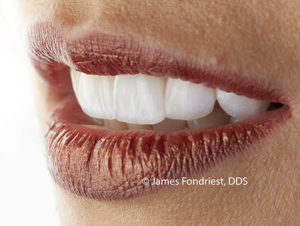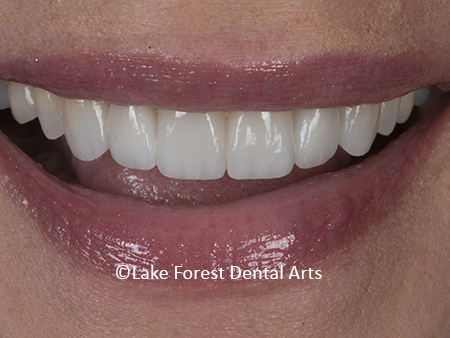
Many patients ask for fake ceramic teeth to hide their smile problems. Dentists call these fake restorations, prosthetics, bridges, crowns, and veneers. We understand that all of these options use ceramic to replace or cover teeth. Fake isn’t always bad, especially after you have suffered trauma or a lost tooth.
What are ceramics?
Dental ceramics and dental porcelain are interchangeable terms. Porcelain was first invented in China around 2,000 years ago. Porcelain was many times more durable and far more attractive than the clay material that had been used before.
While clay was often hardened simply by allowing it to dry, ceramics are hardened using very high temperatures. It was the high temperatures (as high as 2,600 °F) that gave porcelain its strength and beauty.

These 6 ceramic veneers were done for this patient by Dr. Fondriest in 2007 and they still look good. Today, better ceramists can match natural teeth even better.
Dental ceramics are made from glass, silica, and minerals. Dental porcelain remains the material of choice for many dentists because the material:
- Is bio-compatible
- Can be shade matched
- Can be made to have varying levels of transparency
- Has reflective properties similar to enamel
- Does not cause allergic reactions
- Can withstand the natural wear of biting and chewing
- Can be adjusted (drilled) as needed
There is no one type of dental ceramic. If you are seeking fake ceramic teeth, the material used can vary in terms of materials used and fabrication methods.
What are my fake ceramic teeth options?
As mentioned earlier, ceramic restorations will either replace a missing tooth or cover it. Let’s explore these two options.
Fake Ceramic Options for Missing Teeth
If you are missing a tooth, you can be fitted with a dental bridge or a dental implant that can be topped with a crown. One question we are often asked is, “Do fake ceramic teeth look real?” The short answer is yes.
As noted earlier, ceramics can be custom made to exactly match the shade and luster of natural teeth. Once the perfect blend of ceramics has been found, it will be milled by expert lab techs who will capture every small detail needed.
A dental bridge or implant crown placed at our office will look real. Few people (if any) will be able to tell that you had restorative work done.
Dental Bridge
A tooth bridge can replace one or more teeth in a row. If you are missing several teeth, you may need a partial or full denture. A typical bridge uses natural teeth to hold 1 or 2 false ones in place. Candidates should have two healthy teeth that can support the bridge.
The supporting teeth will each have a ceramic crown placed. The crowns will be attached to one or two fake ceramic teeth in between. In order to have a crown placed, part of your tooth’s outer layer will need to be shaved off. This gentle process is done using simple novacaine.
Once your teeth are ready, measurements will be made and a lab will begin making your bridge. When your fake ceramic teeth arrive, the dentist will ensure that the prosthetic fits well. Then, the bridge will be placed using very strong cement.
Implants used to support fake ceramic teeth
A dental implant is generally considered the best option following tooth loss in younger patients. The implant is surgically placed in the jaw. This prevents the loss of bone over time. An implant is also very stable.
A dental implant requires a few to several months to completely heal once it is placed. At that point, a fake ceramic tooth will be placed. Depending on the quality level of your dentist, the fake tooth may appear just like a natural tooth.
Cosmetic or Restorative Treatment options
Ceramics can also be used to cover teeth. This can be for protective or cosmetic reasons. The two options are porcelain veneers and porcelain crowns. Veneers are great for teeth that don’t respond to whitening treatments. Crowns can also be used for whitening your teeth but also for building up broken down teeth.

Dental crown and tooth isolated on a white background
How do porcelain veneers work?
Have you been told that porcelain veneers require extensive removal of enamel? Some dentists offer veneers with no drilling. Many patients do not require their teeth to be partly drilled down.
If the tooth does need to be prepped, typically, only a small amount of enamel is removed.
Careful measurements or images of your tooth will be made. Your tooth colored ceramic shell will be made to enhance the color and shape of your tooth. You may benefit from having the shells placed over all of their visible teeth.
With proper care, porcelain veneers can last for well over a decade. Your shells are stain resistant, but you will want to take steps to preserve the color of nearby teeth.
A non-abrasive toothpaste, good oral hygiene habits, and regular visits to see the dentist will help you make the most out of your cosmetic work.
How do ceramic crowns work?
Another great fake ceramic tooth option is a dental crown. The porcelain cap completely covers a tooth. This treatment is typically done following extensive removal of decay. The cap can also protect a tooth following root canal therapy or to treat a cracked tooth.
For the crown to fit, a layer of your tooth needs to be removed. Then, an impression or mold of your tooth will need to be made. You will be given temporary crowns while you wait.
There are many types of crowns. Most permanent crowns can be very natural looking. The crown material will match the color of your smile. Each crown cover will naturally rest on your gum line. Most forms of dental insurance will partially pay for these restorations.
Dr. Fondriest is a highly sought after cosmetic dentist. He serves clients from throughout the United States
